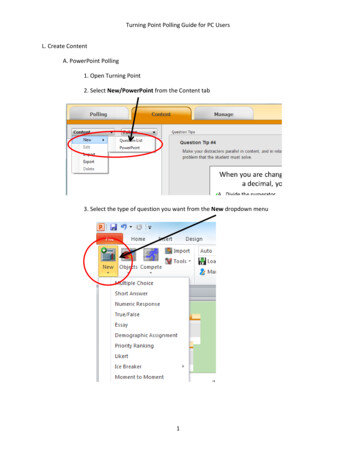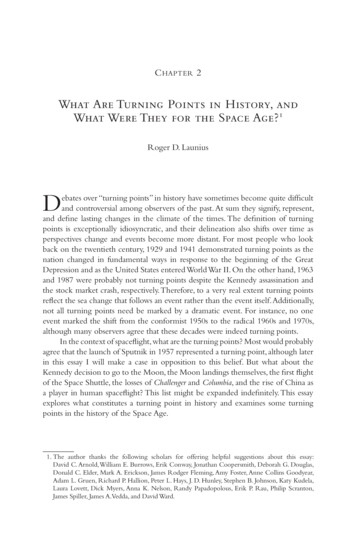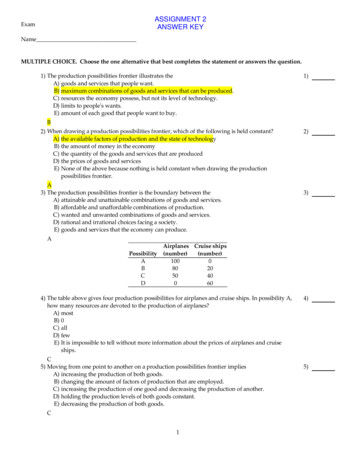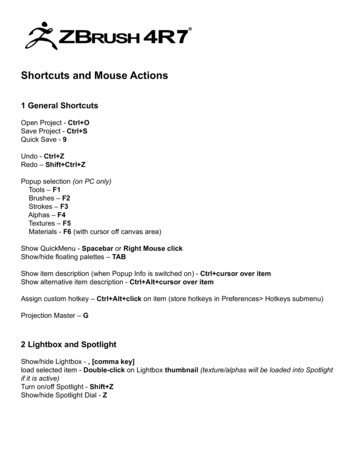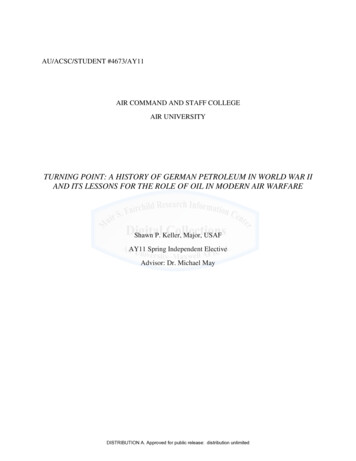
Transcription
AU/ACSC/STUDENT #4673/AY11AIR COMMAND AND STAFF COLLEGEAIR UNIVERSITYTURNING POINT: A HISTORY OF GERMAN PETROLEUM IN WORLD WAR IIAND ITS LESSONS FOR THE ROLE OF OIL IN MODERN AIR WARFAREShawn P. Keller, Major, USAFAY11 Spring Independent ElectiveAdvisor: Dr. Michael MayDISTRIBUTION A. Approved for public release: distribution unlimited
1Turning PointMilitary History is a window through which we may study the lessons of past combat. Theselessons become clear only after thoughtful examination of events and factors that influencedthem. Organizations that have not been willing to examine the past, especially their own,have usually paid a price for that oversight History clearly points out that those who ignorethe past are doomed to repeat old mistakes.--General Robert C. Mathis, USAF“No war for oil!” is a protest frequently heard whenever the United States responds withmilitary power to a crisis in the Middle East. There are some who believe the 1990s Gulf War,and current U.S. conflicts in Iraq and Libya, were inappropriate responses driven purely by U.S.petroleum interests. Others would argue those claims are more rhetoric than reality, and thatAmerica has a larger strategic goal in the region. However, it does beg the question--Is oil reallyworth going to war over? And perhaps more importantly for both politicians and war planners-Is protecting oil a valid strategic military objective? When one examines history, the answer is aresounding yes. Since the birth of the industrial age, crude oil has not only been the life-blood ofan increasingly global economy, but also a determining factor in success or failure on thebattlefield. This is particularly true when one considers the application of air power. In a matterof a few short decades, powered flight drastically changed the face of warfare. And while nearlya century of evolution has transformed air power from a small, supporting actor on the battlefieldinto a dominant force that provides modern nations with rapid and decisive military response,one truth has remained constant. No air force can survive for long without adequate andunrestricted access to oil.Perhaps more than any other modern conflict, World War II demonstrated the strategicadvantage of air power. And equally as significant for air power proponents, the war revealed
2Turning Pointthe vital importance of petroleum to gaining and maintaining air superiority. Without oil, theAllies could never have won. In all of its precious forms, from motor fuel and synthetic rubberto machine lubricants for factories, oil was an indispensible resource. As British Air Ministrymember and air power advocate J.M. Spaight wrote shortly after the war “Modern strategy,tactics and logistics are all founded on and presuppose the possession of the internal combustionengine and its oil, the modern counterpart of the horse and its fodder in the wars of the past.” 1But despite its many advantages, technology has never been able to completely replace thehuman face of war. Time and again since the advent of industrial warfare, troops on the groundhave ultimately decided the outcome of war. World War II was no different in this regard.However, for the first time in history, the war proved that victory on the ground is equallydependent on control of the skies. And it was in the conduct of air warfare that Germany’s lackof oil arguably took its biggest toll.This study will begin with an overview of the German petroleum industry, both beforeand during the war. Particular attention will be focused on Germany’s lack of natural resourceswhich, when combined with the growing demand of fuel for its military, led the Reich to relyheavily on synthetic fuel—an industry that ultimately proved vulnerable to Allied attack. It willthen explore how the constant need for more oil drove German operational planning, resulting inthe Reich’s fateful decision to launch Case BLUE in the summer of 1942 in a last-ditch effort tocapture the Caucasus oilfields. Finally, evidence will be presented to show how protracted warin the East crippled the Luftwaffe’s ability to effectively train its force and defend its remainingpetroleum sources in the German homeland. In what is perhaps the greatest irony of World WarII, Germany’s relentless quest to capture Soviet oil caused them to lose what precious little of itthey already possessed.
3Turning PointGERMAN PETROLEUM INDUSTRY: 1917-1945In order to understand the Luftwaffe’s growing desperation for fuel as the war progressed,it is necessary to examine Germany’s oil situation in the years leading up to World War II.Unlike its neighbors France and Great Britain, post-World War Germany could not rely on itsmeager colonial holdings or a seat at the table with the major American and European oil cartelsto provide much needed crude. It is important to recognize that even if Germany had access toits own overseas oil reserves, the nation suffered such tremendous economic and politicalhardships in the wake of World War I that it likely would not have been capable of maximizingproduction in those early post-war years.As a result, Germany found itself lagging behind and at the mercy of the global oilmarket. France was already a major player in the development of oil in the Middle East as earlyas the 1920s as a major stakeholder in a consortium initially known as the Turkish PetroleumCompany Limited. 2 Later renamed the Iraq Petroleum Company (IPC), the consortium was anearly effort to control oil exploration and production over an enormous swath of Mideastterritory, at a time when many believed an oil shortage was imminent. 3 Across the Channel,Great Britain was enjoying the benefits of not only its stake in IPC, but a handsome 40% share ofRoyal Dutch Shell. 4 By the time war began in 1939, seven oil corporations (five American andtwo European) essentially controlled the global supply of oil. 5When its economy finally began to blossom in the 1930s, Germany quickly realized thatthe meager natural deposits of crude oil under its surface were woefully inadequate to meet thedemands of its growing industrial centers. In an effort to decrease its dependence on importedoil, Germany nationalized the ownership of oil in the Reich in an attempt to speed up the
4Turning Pointexploration and exploitation of domestic crude. 6While the surge in exploratory drillinguncovered significant new oil in Germany’s northwest regions, particularly deposits at Reitbrookand Heide-Meldorf, 7 it was not enough to provide substantial relief. Even if large deposits hadbeen discovered, the waxy nature of German crude prevented it from being useful to the refiningof motor and aircraft fuel—a critical resource for its growing military. However, German crudewas well suited for lubricating oils and indeed provided an adequate supply of the product toboth the defense and civilian manufacturing industries until the Allied bombing of refineriesbegan to curtail its production in 1944 8.The rise of National Socialism brought with it a boom of technology and manufacturingthat restored Germany’s standing as a European industrial power. Hitler’s autarkic policiesensured that most of the Reich’s industrial productivity focused inward on infrastructuredevelopment and domestic products for the German populace. However, the announcement ofHitler’s “Four Year Plan” for the German economy in September of 1936 quickly redirectedmanufacturing efforts toward military aims. In a memorandum drafted a month before the plan’srelease, Hitler stated, “The extent and pace of the military development of our resources cannotbe made too large or too rapid!” 9 The Fuhrer’s policy gave a green light to Nazi leaders whowere quietly developing a plan for European conquest; the success of which required a buildupof massive military power. While the design of German military hardware in World War II islegendary and still touted by historians and military experts to this day for its technologicalbrilliance, manufacture and operation of its war machines added to an already unquenchablethirst for oil.
5Turning PointBy 1938, Germany’s total oil supply had risen to approximately 44 million barrels. 10Of this total, domestic crude oil production accounted for only 3.8 million barrels while 60percent (roughly 28 million barrels) of German oil was imported from overseas where the UnitedStates controlled the lion’s share of production. The remaining imports came overland fromEuropean sources (3.3 million barrels from Romania alone 11), while another 9 million barrelswere derived from the Reich’s growing synthetic oil industry. 12 While this amount is scant incomparison to the 1 billion barrels that were domestically produced by the United States, or eventhe 183 million barrels produced by the Soviet Union in that same year, 13 Hitler and his ministersknew that their pending plans for a European military campaign would dramatically increasedemand.Once war began in 1939, German industrial production grew at an exponential rate asbattlefronts expanded and attrition rates for aircraft, ships and vehicles mounted at a frenziedpace. The Luftwaffe, for example, took delivery of 8,300 aircraft in 1939—a number thatexploded to a peak production of 39,800 by 1944. 14 With the disappearance of foreign importsfrom the west as a result of the Allied blockade, Germany took swift action to alleviate itsdesperate demand for oil. As the war escalated and fuel reserves began to tighten, production ofdomestic crude was stepped up dramatically, as was production of synthetic petroleum. Turningto their neighbors in the east, Germany pressed both Romania and the Soviet Union tosignificantly increase current oil exports. Romania was particularly critical to the Reich’s oilstockpile program, producing 8 million barrels for German export in 1940—a staggeringincrease of 4.7 million barrels in only two years. 15 By comparison, Soviet Union exports to Authors note: Oil and aviation fuel quantities from this era were normally provided in metric tons. Conversion tothe common U.S. measurement standard of barrels and gallons were calculated using the United States EnergyInformation Administration website (www.eia.doe.gov) and will be used throughout this study.
6Turning PointGermany only amounted to 4.5 million barrels—despite the fact that the USSR sat squarely ontop of the world’s largest oil reserves. 16 By January 1941, six months before Hitler launched theSoviet invasion, Germany had managed to build petroleum reserves to an estimated 56 millionbarrels.THE RISE OF SYNTHETIC OILScientists had been experimenting with the technology of converting coal into oil sincethe early 20th century. Both products contain a similar mixture of basic hydrocarbons, so theprocess seemed to be a natural evolution as new developments in both manufacturing andchemistry emerged. Despite its possibilities, coal synthesis tended to be a process largelyignored by the rest of the world, particularly those nations with ready access to natural crudeoil—the United States included. Germany, however, anxiously embraced synthetic petroleumtechnology even prior to World War I. 17 Germany’s aggressive development of synthetic fuel isin many ways the essential element that allowed the Reich to continue waging war long after theAllied blockade of September 1939 essentially cut off imports of crude oil.It was as much Hitler’s quest for German self-determination as actual oil demand thatdrove the Reich’s burgeoning synthetic fuel industry. World War I taught Germany a brutallesson. Their scarce organic oil resources made them vulnerable to reliance on other nationsduring the war, particularly Austria-Hungary and neighboring Romania. Germany experienced asevere oil crisis in the latter years of the Great War that significantly altered their strategicmilitary objectives. Eerily reminiscent of Operation BARBAROSSA more than two decadeslater, Germany developed a plan to capture of the rich Baku oilfields in the Caucasus. However,
7Turning Pointthe British beat Germany to Baku in August 1918 dealing the Kaiser’s army a serious blow.18As Europe careened toward war in 1938, Germany did not intend to lose the race for oil again.Germany saw synthetic petroleum as a way to use its existing organic coal to decreasereliance on foreign imports, while at the same time fill the growing need for fuel. Coal was thecornerstone of the German economy. Comprising 90% of Germany’s energy consumption by1937, coal was a natural resource that the Reich had in abundance. 19 German mines were morehighly mechanized than those of other European coal producers, an advantage that allowed themto out-produce their neighbors. For example, in 1938 the German coal output per man-hourexceeded that of Great Britain by one-third and was double that of peer competitors France andBelgium. 20 Germany produced 187.5 million tons of coal between 1938-1939, prior to theinvasion of Poland. The production of coal increased between 1939-1944, reaching a peak of268.9 million tons in 1944 21. Part of that increase was a windfall from the coal rich regions inCzechoslovakia and Poland that were captured in the early years of the war. However, Germanywas able to slightly increase its domestic coal production as well in an attempt to meet thegrowing demand for synthetic fuel and steel production.Working to capitalize on Germany’s abundant coal resources, German engineersdeveloped a method to chemically synthesize coal into liquid petroleum.German scientistFriedrich Bergius pioneered the process, inventing an early high-pressure coal hydrogenation(liquefaction) procedure between 1910-1925. A decade later, Bergius began working with FranzFischer and Hans Tropsch at the Kaiser-Wilhelm Institute for Coal Research (KWI) in Mülheim.Together they discovered a second coal conversion process, known as Fisher-Tropsch (F-T).When combined with hydrogenation, the two processes allowed Germany to establish the world'sfirst technologically successful synthetic liquid fuel industry. 22 The results were impressive.
8Turning PointWhen a group of American oil executives visited an early German synthetic plant in 1926, thenStandard Oil president Walter Teagle remarked, “We were babies compared to what they weredoing. I had not known what (synthetic) research meant until I saw it”. 23German chemical giant IG Farben entered the realm of synthetic petroleum productionwith its first processing plant at Leuna in 1927. Production in that first year of operation yieldedan impressive 2.2 million barrels, which was soon increased to an average output of 3.6 millionannually. 24 It is little wonder that Germany was optimistic about the capabilities of syntheticfuel. So confident was Germany in their new technology that I.G. Farben Director, Dr. HeinrichBütefisch, stated during post-war interrogations that it was the Reich’s intention “that half of thewhole of the oil used in Germany should be synthetic.” 25Whether a by-product of thisenthusiasm, or a result of Hitler’s demand for a petroleum independent Germany in his FourYear Plan, between 1934-1935 four additional I.G. Farben plants were constructed at Böhlen,Magdeburg, Schwarzheide and Zeitz. 26 By this time, other German chemical companies such asRuhrchemie and Friedrich Krupp AG began liquid fuel production operations and by the end of1945 twelve coal hydrogenation plants and nine F-T plants had been constructed.27However successful synthetic oil may have been at granting Germany some degree ofpetroleum independence, the technology did not come cheap. Capital and construction costs forthe average F-T plant were on average RM 30 million ( 75 million) . Production costs forsynthetic oil and refined fuel products were also exponentially higher than that for natural crude.The average manufacturing cost for a barrel of synthetic oil was between RM 32-45 ( 13-18)and processed fuel values averaged 23-26 pfennig per kg (approximately 31-44 cents per All figures are based on financial values for the period. No inflationary adjustments have been made to reflectcurrent values.
9Turning Pointgallon). 28 In comparison, a barrel of crude oil traded for 93 cents on the U.S. commoditiesexchange in December 1939 and in the same month a gallon of regular gasoline sold for 13.4cents at the average New York City service station. 29Early funding for synthetic development was primarily derived from capital investmentby the companies themselves or from private investors and banks. However, by 1939 the costsof production grew untenable for private industry and the German government began absorbingmore and more of the cost. A report in March 1939 stated that of the RM 132 million ( 328.6million) already spent on synthetic fuel that year, the government contributed an estimated RM70 million ( 174.3 million) in the form of manufacturing equipment purchases. 30 The high costof production did little to hamper Germany’s continued investment and reliance on the syntheticpetroleum industry. By the eve of war in 1939, annual German synthetic production had grownto 16.7 million barrels. 31 During its highest year of production in 1943, Germany produced 42million barrels of synthetic petroleum; far exceeding the 34 million barrels of crude oildomestically produced or imported during the same period. 32Aviation gasoline was one of the driving forces behind the increase in syntheticpetroleum production. The Luftwaffe itself carried out blending of aviation gasoline, and ofparticular interest to them was the high-grade oil that could only be produced through thehydrogenation method rather than F-T. 33 By January 1941, Germany had stocks of aviation fueltotaling 219.5 million gallons, of which ninety-percent was a product of the synthetic fuelindustry. However, war with the Soviet Union that summer and fall did not go as planned. Thequick victory predicted by Hitler had turned into a protracted winter war and by the end of 1941aviation fuel reserves were down to 91 million gallons. 34Although synthetic productionincreased substantially in 1943 into early 1944 and boosted aviation fuel reserves, quantities
10 Turning Pointwould never come close to the January 1941 figures. German supply would not be able to keepup with Luftwaffe demand for the rest of the war.By most standards, Germany’s synthetic fuel was a technological wonder, and equal inquality and performance to fuel refined from oil. This was particularly true of German dieseland motor gas. Development of high-performance aviation fuel proved to be the one exception.By the 1930s, standard aviation gasoline had an octane rating of 75-80 35.However, abreakthrough in gasoline technology occurred in the United States in 1935 that made ittechnically possible to produce aviation gas of up to 100 octane. By 1939, both the U.S. ArmyAir Corps and the RAF were using this higher-octane gasoline, allowing them to develop morepowerful engines such as the Rolls Royce Merlin.The net result was that U.S. and British aircraft were now able to fly 15 percent faster,increased their long-range bomber distance by 1,500 miles, and lifted altitude ceilings by 10,000feet. 36 Ironically, Germany had also discovered a similar technology for high-test aviation fuel,however it proved to be much more cumbersome and expensive to produce than the Americanmethod. 37 As a result, the Luftwaffe did not demand high-octane fuel until late in the war whenGerman engineers were working feverishly to develop aircraft engines that could compete withthe newer and faster Allied fighters. Unfortunately for Germany, Allied assaults against thesynthetic fuel plants had already made production of higher-octane fuel virtually impossible.Germany never obtained aviation fuel equal in quality to the Allied air forces, and Luftwaffeaircraft development suffered greatly for it.
11 Turning PointSOVIET OIL AND WAR IN THE EASTMuch has been written regarding the Wehrmacht’s crushing defeat in the Sovietcampaigns, and it is not the purpose of this study to provide intricate details of the ground war inthe East. However, any examination of German air power, particularly on the Eastern Front,must give ample consideration to details on the ground. Increasing limitations on aircraft andfuel and the vast airspace over the Soviet Union combined with fundamental elements of Germanair doctrine to relegate the Luftwaffe, at least initially, to a tactical support arm of the Army in theEast. While long-term plans called for the expansion of a broader, more strategic role for airpower against Soviet lines of communication and industry, the Luftwaffe was simply notequipped or prepared to conduct these missions simultaneously. As Generalleutnant HermannPlocher, commander of the Luftwaffe V Air Corps during the Soviet campaigns, recalled:“ Operations against the Soviet arms industry, especially in the Urals, were postponed until afterthe end of mobile ground operations, probably because any earlier attempt to carry out suchmissions would seriously overtax the Luftwaffe. Therefore, German air strikes were to bemainly tactical in nature, often in close support of ground forces, with the objectives ofeliminating Russian air forces and disrupting Soviet communications.” 38Additionally, it is important to examine the overall conduct of war in the East from 1941-1942as it was the leading factor in determining the overall fate of Germany’s oil supply. Particularattention must be given to how Germany’s failure to decisively defeat the Soviet Army in shortorder exacerbated the Reich’s fuel position; becoming the deciding factor in subsequent planningfor the German summer offensive of 1942.
12 Turning PointOperation BARBAROSSA began on June 22, 1941 with a sweeping attack that extendedalong a 1,400-mile long front from the Arctic Ocean to the Black Sea. As overwhelming asGermany’s continuation of Blitzkrieg on a grand scale must have first seemed to the surprisedSoviet Army, within weeks it was readily apparent that the Fuhrer’s guarantee of a short warwould not come to fruition. Several of Germany’s senior military advisors were skeptical ofHitler’s assumption that the war would be over before winter, including Field Marshal ErhardMilch, State Secretary of Aviation, who remarked:“I had been then asked whether or not we should prepare for winter. This was months inadvance. I thereupon gave the order to prepare everything for winter; the war will last severalyears in the East. At that time the official opinion was otherwise.”39By the end of 1941 Germany found itself bogged down in a brutal winter campaign that it wasgrossly ill prepared to wage, in the home court of a Soviet enemy that was not as “primitive” asHitler and the Reich war planners had mistakenly assumed.To make matters worse, Germany was using far more of its fuel resources than had beencalculated in the initial plans for BARBAROSSA. In the case of the Luftwaffe, fuel expendituresfor the Soviet campaign were significant. In the first half of 1941 prior to the invasion, theLuftwaffe used an estimated 148 million gallons of aviation fuel. From June through Decemberthat amount more than doubled to 307 million, just slightly less than the 309 million gallons offuel used by the Luftwaffe for the entire year in 1940. 40 Total German production of aviation fuelin 1941 was only 326 million gallons—a significant deficit in light of the 456 million gallonsused for the year. As a result, Luftwaffe fuel reserves fell dramatically from 219 million gallonsin January 1941 down to 91 million by December.41The Reich’s weakened oil supply wasreadily apparent not only to Hitler and his economic ministers, but was also noticed by Allied
13 Turning Pointintelligence agencies. The British Air Ministry Weekly Intelligence Summary (AMWIS) fromFebruary 18th, 1942 made the following observation regarding Germany’s fuel position:The Russian campaign, which so greatly exceeded in scale any previous mechanized battles, hasrun down even the considerable stocks which Germany had last June to a level which is morethan uncomfortably low, and the “oil expert” can at last lay his hand on his heart and say theGerman’s are likely to run out of oil before very long—unless they get the Caucasus withoutdelay. 42The Soviet counter-offensive in the winter of 1941-42 finally convinced Hitler that itwould be foolish to risk a continued push for Moscow. His dreams of a triumphant marchthrough Red Square were dashed for good, but the Fuhrer knew Germany could not remain onthe defensive in the east. The Soviet Union had the oil, food and raw materials that the Germanmilitary desperately needed to continue the war. Although the Reich’s offensive planning for thesummer of 1942 was limited in nature when compared to the massive invasion it had launchedthe previous year, Hitler still believed that a successful push in the direction of Stalingrad and theCaucasus oil fields was both possible and necessary.While grandiose considering the Wehrmacht’s current situation in the Soviet Union,Hitler’s new strategy in the East was to penetrate deep into the southwest reaches of theCaucasus, opening a potential avenue to move a portion of his forces into Turkey which hehoped would enter the war on the side of the Axis. Hitler calculated that this move wouldprotect his right flank from the Soviet Army and allow him to threaten a push into Iran, possiblyforcing Great Britain to broker a deal for peace on generous terms before the industrial might ofthe United States entered the war in full force. But first, Germany had to capture the Caucasusoil fields and alleviate the petroleum crisis that was threatening to destroy the entire war. Fuhrer
14 Turning PointDirective 41 was released on April 5th, 1942 with operations planned to commence the followingmonth.The plan, code named Fall Blau (Code BLUE), essentially divided the remainingWehrmacht forces of Army Group South in two. Army Group A, spearheaded by the First PanzerArmy, was to head south and capture the oilfields a Grozny and Maikop before crossing theCaucasus Mountains to take the main objective—the immense reserves at Baku. Army Group B,led by the 4th Panzer Army, would attack toward the southeast from Kharkov in the direction ofStalingrad and the Volga. It’s main effort would be to both block concentrations of the SovietArmy along the Don River from attacking Army Group A’s main thrust toward the oilfields, andto deliver a crippling blow to Soviet supply lines and industrial centers in the south.The plan was a gamble, but the Reich had few options on the table in light of thetremendous toll the winter campaign had taken on the Wehrmacht. Blitzkrieg had died in thesnow and mud of the Russian steppes and Germany had no choice but to reinvent its army andair force to fight a protracted war. From a strategic perspective, the oilfields were a logicalobjective and a risk worth taking for the Germans. British Ministry of Economic Warfareproduction estimates for 1942 suggested that Maikop and Grozny were each producingapproximately 18.3 million barrels of oil annually. Baku, the Crown Jewel of Caucasus oilproduction and one of the world’s richest oilfields, was capable of churning out a staggering 176million barrels per year. 43 Control of Caucasus oil would not only provide a permanent solutionto the German oil crisis. It would be a deathblow to Soviet war production and allow Germanyto continue the fight against its growing list of adversaries, which now included the UnitedStates.
15 Turning PointMilitary historian, Dr. Joel Hayward, best describes how Hitler’s planning and executionof Code BLUE was a significant divergence from traditional military strategy:Operation BARBAROSSA had been conceived in basic accordance with Clausewitz’sfundamental rule of warfare that the proper objective of a campaign is the defeat of the enemy’smilitary forces in the field and that the seizure of economic and political objectives must follow,not precede, this. However, Hitler’s decision in the winter of 1941/42 to seize the Caucasusoilfields, rather than force a decisive battle on the Soviet armed forces, violated Clausewitz’srule (his decision) was based, not on ignorance of the basic tenets of military theory, but ondeep concern over his struggling economy and the perceived lack of feasible alternativestrategies. 44But as Hayward also wisely pointed out, unlike Clausewitz, Hitler was commanding mechanizedarmies in a war between major industrialized nations. Now more than ever, the fate of the Reichdepended on Caucasus oil. The dire situation prompted Hitler to declare during a meeting withhis senior officers from Army Group South; “If I do not get the oil of Maikop and Grozny then Imust end this war”. 45The main thrust toward the Caucasus was delayed in May 1942 by unexpected Sovietresistance around the Kerch peninsula in the Crimea. 46 This might have served as a harbingerfor the Germans of the disaster that awaited them in the south, however, once D-Day for CaseBlue commenced in earnest on June 28th, early success by the Wehrmacht greatly encouragedHitler and the German high command. German forces quickly advanced from Kharkov, crossingthe Donetz River and heading toward the Don with little resistance from the Soviet Army, whichwas seemingly overwhelmed by the offensive. By August 9th, Army Group A had taken theoilfields at Maikop and continued to push south at a rapid pace. On August 21st, Hitler was
16 Turning Pointbriefed that Bavarian mountain troops had raised the Nazi flag on the summit of Mount Elbus,the highest point in the Caucasus. 47At this point, Hitler made a fateful decision that many historians consider the turningpoint of the war. Concerned that Army Group South would be attacked from the flank as it madeits way down the Don-Donetz corridor, he ordered the 6th Army to proceed alone to Stalingrad,which it was then directed to seize a
human face of war. Time and again since the advent of industrial warfare, troops on the ground have ultimately decided the outcome of war. World War II was no different in this regard. However, for the first time in history, the war proved that victory on the ground is equally dependent on control of the skies.


